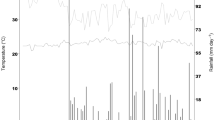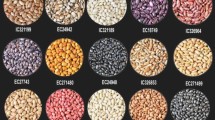Abstract
Growth trials were conducted outdoors in the UK to determine the yield, yield components and plant architectural differences between determinate and indeterminate Phaseolus vulgaris bean plants. F3 lines derived from crosses between ‘Prelude’, a determinate cultivar and ‘V8’, an indeterminate landrace, were grown together with the parents and ‘Carioca’, an indeterminate landrace from Brazil. Data were recorded on flowering date, number of nodes on main stem at flowering, plant height at maturity, number of pods/plant, number of seeds/pod, number of seeds/plant, 100-seed weight, seed mass/plant, percentages of diseased and healthy seeds/plant. Determinate F3 lines had significantly lower (P < 0.05) seed mass/plant, fewer pods/plant, fewer seeds/pod, fewer seeds/plant, lower harvest index, shorter stems, earlier date of flowering, fewer nodes at flowering and fewer healthy seeds/plant than indeterminate F3 lines. However, determinate genotypes had significantly larger (P < 0.05) pods to accommodate their larger seeds compared with indeterminate lines. A similar situation was found when the yield and yield components of ‘V8’, ‘Prelude’ and ‘Carioca’ were evaluated; the highest seed mass/plant was given by ‘V8’ and the lowest by ‘Prelude’. Furthermore, some indeterminate genotypes with Type IV growth habit yielded significantly higher (P < 0.05) than the high-yielding parent, ‘V8’, indicating a positive influence on seed yield by crossing different genotypes.

Similar content being viewed by others
References
Acosta-Gallegos JA, Adams MW (1991) Plant traits and yield stability of dry bean (Phaseolus vulgaris L.) cultivars under drought stress. J Agric Sci 117:213–219
Acquaah G, Adams MW, Kelly JD (1991) Identification of effective indicators of erect plant architecture in dry beans. Crop Sci 31:261–264
Ayaz S, McKenzie BA, Hill DG, McNeil DL (2004) Variability in yield of four grain legume species in a subhumid temperate environment. I. Yields and harvest index. J Agric Sci 142:9–20
Beaver JS, Paniagua CV, Coyne DP, Freytag GF (1985) Yield stability of dry bean genotypes in the Dominican Republic. Crop Sci 25:923–926
Boutraa T, Sanders FE (2001) Effects of interactions of moisture regime and nutrient addition on nodulation and carbon partitioning in two cultivars of bean (Phaseolus vulgaris L.). J Agron Crop Sci 186:229–237
Casquero PA, Lema M, Santalla M, de Ron AM (2006) Performance of common bean (Phaseolus vulgaris L.) landraces from Spain in the Atlantic and Mediterranean environments. Gen Res Crop Evol 53:1021–1032
CIAT (Centro Internacional de Agricultura Tropical) (1974) Bean Program 1973 Annual Report, CIAT, Cali, Colombia, 170–175
Coyne DP (1965) Component interaction in relation to heterosis for plant height in Phaseolus vulgaris L. variety crosses. Crop Sci 5:17–18
Coyne DP (1968) Correlation, heritability, and selection of yield components in field beans, Phaseolus vulgaris L. Proc Am Soc Hortic Sci 93:338–396
Dapaah HK, McKenzie BA, Hill GD (2000) Influence of sowing date and irrigation on the growth and yield of pinto beans (Phaseolus vulgaris L.) in a sub-humid temperate environment. J Agric Sci 134:33–43
Dawo MI, Wilkinson JM, Sanders FE, Pilbeam DJ (2007) The yield and quality of fresh and ensiled plant material from intercropped maize (Zea mays) and beans (Phaseolus vulgaris). J Sci Fd Agric (in press)
Garcia EH, Pena-Valdivia CB, Rogelio-Aguirre JRR, Muruaga JSM (1997) Morphological and agronomic traits of a wild and an improved cultivar of common bean (Phaseolus vulgaris L.). Ann Bot 97:207–213
Gepts P, Osborn TC, Rashka K, Bliss FA (1986) Phaseolin protein variability in wild forms and landraces of common bean (Phaseolus vulgaris L.): evidence for multiple centers of domestication. Econ Bot 40:451–468
Graham PH, Ranalli P (1997) Common bean (Phaseolus vulgaris L.). Field Crops Res 53:131–146
Husain MM, Hill GD, Gallagher JN (1988) The response of field beans (Vicia faba L.) to irrigation and sowing date. I. Yield and yield components. J Agric Sci 111:233–245
Kelly JD, Adams MW (1987) Phenotypic recurrent selection in ideotype breeding of Pinto beans. Euphytica 36:69–80
Kelly JD, Adams MW, Varner GV (1987) Yield stability of determinate and indeterminate dry bean cultivars. Theor App Gen 74:516–521
Kornegay J, White JW, Ortiz de la Cruz O (1992) Growth habit and gene pool effects on inheritance of yield in common bean. Euphytica 62:171–180
Laing DR, Jones PG, Davis JHC (1984) Common beans (Phaseolus vulgaris L.). In: Goldsworthy PR, Fisher N (eds) The physiology of tropical field crops. Wiley, New York, pp 305–352
Lynch JP, van Beem J (1993) Growth and architecture of seedling roots of common bean genotypes. Crop Sci 33:1253–1257
Mumba LE, Galwey NW (1998) Compatability of crosses between gene pools and evolutionary classes in common bean (Phaseolus vulgaris L.). Gen Res Crop Evol 45:69–80
Nichols MA, Ragan P, Floyd RM (1985) Temperature and plant density studies with vining peas. In: Hebblethwaite PD, Heath MC, Dawkins TCK (eds) The pea crop—a basis for improvement. Butterworths, London, pp 173–184
Nienhuis J, Singh SP (1986) Combining ability analyses and relationships among yield, yield components, and architectural traits in dry bean. Crop Sci 26:21–27
Samper C, Adams MW, Henson AD, Watt E (1984) Contribution of stored assimilates to the seed following a drought stress in dry beans. Agron Abst 76:8787
Sarafi A (1978) A yield component selection experiment involving American and Iranian cultivars of common bean. Crop Sci 18:5–7
Singh SP (1988) Morphological, physiological and biochemical changes in Phaseolus beans under domestication. In: Gepts P (ed) Genetic resources of Phaseolus beans their maintenance, domestication, evolution and utilization. Kluwer, Dordrecht, Netherlands, pp 143–161
Singh SP (1991) Bean genetics. In: Van Schoonhoven A, Voysest O (eds) Common beans: research for crop improvement. CAB International, Wallingford, UK, pp 199–286
Singh SP, Cajiao C, Gutiérrez JA et al (1989) Selection for seed yield in inter-gene pool crosses of common bean. Crop Sci 29:1126–1131
Singh SP, Terán H, Muñoz CG et al (2003) Low soil fertility tolerance in landraces and improved common bean genotypes. Crop Sci 43:110–119
Smartt J (1969) Evolution of American Phaseolus beans under domestication. In: Ucko PJ, Dimbleby GW (eds) The domestication and exploitation of plants and animals. Aldine, Chicago, pp 451–462
Welsh W, Bushuk W, Roca W, Singh SP (1995) Characterization of agronomic traits and markers of recombinant inbred lines from intra- and interracial populations of Phaseolus vulgaris L. Theor App Gen 91:169–177
White JW, González A (1990) Characterization of the negative association between seed yield and seed size among genotypes of common bean. Field Crops Res 23:159–175
White JW, Izquierdo J (1991) Physiology of yield potential and stress tolerance. In: Van Schoonhoven A, Voysest O (eds) Common beans: research for crop improvement. CAB International, Wallingford, UK, pp 278–382
White JW, Kornegay J, Castillo J et al (1992) Effects of growth habit on yield of large-seeded bush cultivars of common bean. Field Crops Res 29:151–161
Acknowledgements
Thanks to Mr M. Lappage for help with growing the plants. The work was funded by a scholarship from the Islamic Development Bank to one of us (MID).
Author information
Authors and Affiliations
Corresponding author
Rights and permissions
About this article
Cite this article
Dawo, M.I., Sanders, F.E. & Pilbeam, D.J. Yield, yield components and plant architecture in the F3 generation of common bean (Phaseolus vulgaris L.) derived from a cross between the determinate cultivar ‘Prelude’ and an indeterminate landrace. Euphytica 156, 77–87 (2007). https://doi.org/10.1007/s10681-007-9354-1
Received:
Accepted:
Published:
Issue Date:
DOI: https://doi.org/10.1007/s10681-007-9354-1




